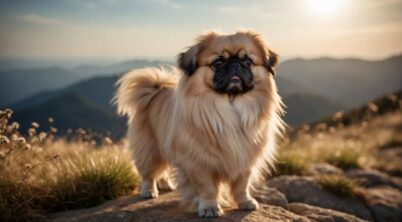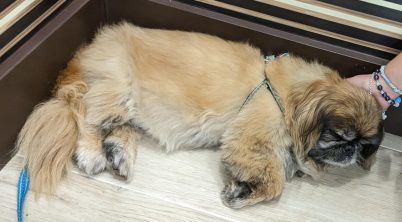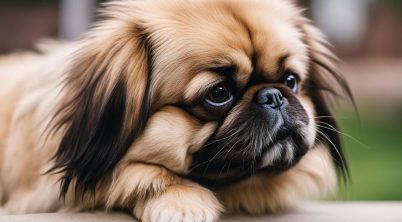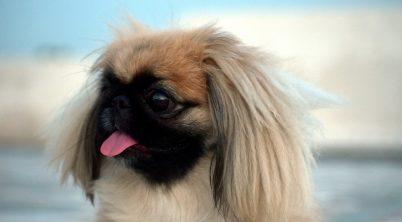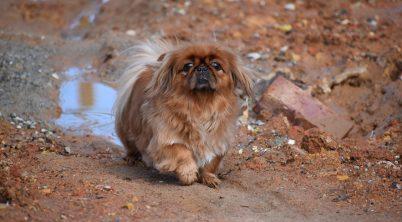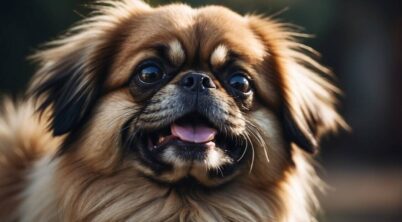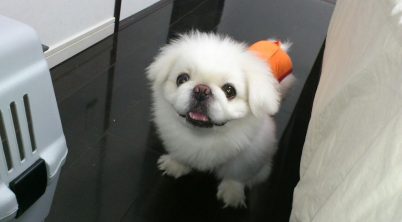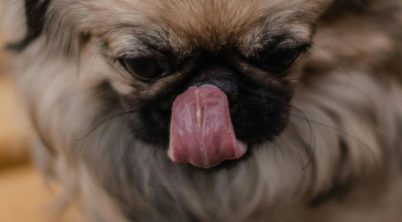The Pekingese is an ancient toy dog breed, deeply entwined with Chinese royalty and history. Originating in China, these small dogs were highly esteemed by the Chinese Imperial court where they served as companion animals. With their distinctive appearance, the breed was often associated with Chinese deities and was considered a symbol of good fortune and protection. They were so valued that for centuries, commoners had to bow to them, and theft of a Pekingese was punishable by death.
The breed’s name itself is a reference to Beijing, formerly known as Peking, where the Forbidden City, the Chinese Imperial palace, is located. This close relationship with the elite not only illustrates the Pekingese’s revered status but also underscores the breed’s exclusivity and the strict preservation of its lineage. Despite their small size, the Pekingese boasts a lion-like mane, earning them the nickname “Lion Dogs” among the nobility. This moniker echoes the breed’s purpose to replicate the regal appearance of lions, which are important symbols in Chinese culture and mythology.
Across dynasties and through time, the Pekingese has maintained its stature as a breed of nobility. While they were initially exclusive to the imperial family and Chinese aristocrats, some of these esteemed dogs made their way to the West in the late 19th century. This happened notably after the British invasion of the Forbidden City in 1860 when several Pekingese were taken and presented to Queen Victoria, marking the beginning of the breed’s global dispersion. Through the centuries, the Pekingese has remained a beloved and dignified breed, cherished for its history and its close association with the opulence and culture of Chinese royalty.
Table of Contents
Pekingese Chinese Royalty
The Pekingese dog boasts a regal history deeply intertwined with Chinese royalty. These small, toy-sized dogs were the esteemed companions of the Imperial family within the Forbidden City.
Origins:
- Geographic: Beijing (formerly Peking), China
- Setting: Chinese Imperial Court
Characteristics:
- Appearance: Lion-like mane, distinctive flat face
- Size: Toy breed classification
- Temperament: Loyal but aloof with strangers
Known for their unique and elaborate appearance, the breed became a symbol of prestige; the ownership of Pekingese was once restricted to Chinese nobility. They were treasured for their companionship and often associated with spiritual protection against evil forces.
| Historical Significance | Description |
|---|---|
| Imperial Exclusivity | Only royalty could own Pekingese. |
| Lion Connection | Believed to resemble mythical Chinese guardian lions. |
| Cultural Impact | Represented as dowry gifts to solidify alliances. |
The Pekingese served not just as pets, but as status symbols and living representations of Chinese culture and mythology. They are often marked by a proud and somewhat independent nature—a trait cultivated through centuries of selective breeding by the royals. Despite their small stature, they carry a dignified presence.
Efforts to preserve the lineage and characteristics of the Pekingese were meticulously undertaken, with many of the finest specimens kept within the royal palace. Even after spreading to other parts of the world, the Pekingese has maintained an air of its noble lineage.
Origins and Historical Significance
The Pekingese dog is deeply rooted in ancient China, with a history as regal as the imperial families they served. These dogs bear witness to both the splendor of the Chinese courts and the shifting tides brought on by Western influences.
Ancient China and the Imperial Family
The Pekingese breed originated during the Tang Dynasty, serving as the cherished companions of the imperial family in ancient China. Selectively bred for their unique appearance and size, they were a fixture in the opulent lives of emperors and empresses, symbolizing wealth and nobility. This exclusive ownership was so important that commoners had to bow to these esteemed dogs, reflecting their significant status within the confines of the Forbidden City in Beijing.
Pekingese and the British Influence
The intersection of the Pekingese’s fate with British involvement came during the Second Opium War. In 1860, British troops invaded the Summer Palace in Beijing. A small dog found amidst the turmoil was taken and presented to Queen Victoria, who named it Looty. This pivotal moment marked the breed’s introduction to the West. Captain John Hart Dunne was one of the British soldiers involved in this historical event, and he took particular interest in the breed. The Pekingese became hugely popular in Britain after Theodore Roosevelt witnessed their appeal. The formation of the Pekingese Club in England cemented the breed’s status among Western dog enthusiasts and facilitated the spread of the breed across the world.
Physical Characteristics
The Pekingese breed boasts distinctive traits that adhere to centuries-old standards, reflecting its storied history within the Chinese Imperial court. These dogs are known for their lion-like mane and bold presence in a compact form.
Breed Standards and Appearance
Physically, the Pekingese presents a regal and confident stance. Adult Pekingese typically weigh between 7 to 14 pounds and have a stocky, muscular build. They stand no more than 6 to 9 inches at the shoulder, making them a member of the toy group.
- Flat Face: A defining feature is their brachycephalic, or flat face, with a broad skull and a short snout.
- Eyes and Ears: Large, round eyes and heart-shaped ears that lie flat against the head enhance their expressive appearance.
The breed’s standard includes a body that is low to the ground with a noticeably rolling gait due to their slightly bowed limbs.
| Body Feature | Description |
|---|---|
| Size | Small, typically not exceeding 9 inches in height |
| Weight | Between 7 and 14 pounds |
| Head | Wide skull, flat face with a distinct short snout |
| Eyes | Large, prominent and dark |
| Ears | Heart-shaped, set at eye level and lie flat against the head |
| Coat | Long, straight, with a profuse mane, giving a “lion’s mane” appearance |
Coat Varieties and Grooming
The Pekingese possesses a double coat that consists of a thick undercoat and a long, straight, and coarse outer coat. The coat can be found in various colors such as:
- Red
- Tan
- Fawn
- Black
- White
- Cream
- Gold
- Sable
Regular grooming is essential to maintain the health and appearance of the Pekingese’s coat. Brushing a few times a week helps manage shedding and prevents mats from forming, especially in the longer mane-like fur around the neck.
The grooming routine for this breed includes:
- Brushing: At least three times a week with a bristle brush or a long-toothed comb to remove tangles.
- Bathing: Monthly baths help keep the coat clean and reduce shedding.
- Eye Care: Due to their flat face and prominent eyes, regular cleaning can prevent irritation.
| Care Type | Details |
|---|---|
| Brushing | Minimally thrice weekly to maintain coat and prevent mats |
| Bathing | Typically recommended once a month |
| Shedding | Undercoat sheds seasonally; frequent grooming minimizes loose fur |
Maintaining the Pekingese’s coat in good condition is not only about aesthetics but also about comfort and health, given their susceptibility to overheating due to their dense fur.
Behavior and Temperament
The Pekingese is a breed with a distinct set of personality traits and behaviors, shaped by its historic role as a companion to Chinese royalty. They are known for their affectionate yet independent nature.
Personality Traits
The Pekingese is often described as having an affectionate disposition, showing loyalty and a desire to be close to their owners. However, they balance this with an independent streak, not always seeking the constant attention that other lapdog breeds might. This breed can be stubborn at times, which may require patience and consistent training methods. They are also intelligent and alert, traits that make them excellent watchdogs despite their small size.
The Pekingese are known to form strong emotional bonds with their families, often becoming particularly attached to one person. They can be quite protective of their owners, a quality that sometimes leads to a display of bravery that belies their compact form.
Interactions with Families and Children
When it comes to families, Pekingese can be loving pets, showing affection and loyalty. They are suitable for families with older children who understand how to interact with them carefully and respectfully. Due to their small size and personal dignity, they may not be the ideal companion for families with very small children who may inadvertently handle them too roughly or without consideration for the dog’s independence and temperament.
The Pekingese may exhibit a certain level of patience and tolerance but generally prefer not to be overly fussed over or mishandled. Supervision is recommended when they are interacting with children, to ensure the safety of both the child and the pet. The Sleeve Pekingese, a smaller version of the breed, may require even more careful handling due to its diminutive size.
The Pekingese in Modern Culture
The Pekingese has transitioned from the laps of Chinese royalty to becoming a cherished companion dog across the globe, maintaining its dignified demeanor and distinctive gait.
Role as a Companion Dog
The Pekingese, with its regal heritage, maintains a strong presence as a companion dog. Prominent for their affectionate nature and loyal companionship, these dogs carry an air of dignity in modern households. Despite their royal past, Pekingese are adaptable and fit well into various home environments, bonding closely with their owners. Their unique rolling gait and poise retain the elegance of their history.
Popularity and Breed Clubs
Pekingese remain popular in the dog community, reflected in the establishment of various breed clubs. The American Kennel Club (AKC) classifies Pekingese as a toy breed, a category for dogs that are primarily companion dogs. The Pekingese clubs around the world are dedicated to preserving the breed’s standard, which includes maintaining their characteristic coat color and ensuring the breed does not exceed a certain weight.
Enthusiasts and breeders continue to uphold the Pekingese’s historical lineage by participating in dog shows and maintaining associations such as the Pekingese Club of America. This platform ensures that the breed’s standards, including those set by AKC, are upheld. Additionally, the Pekingese’s influence can be seen in other breeds such as the Shih Tzu and the Pug, which share similar origins and attributes.
* Banner photo by Yi Su, cropped | Some rights reserved

